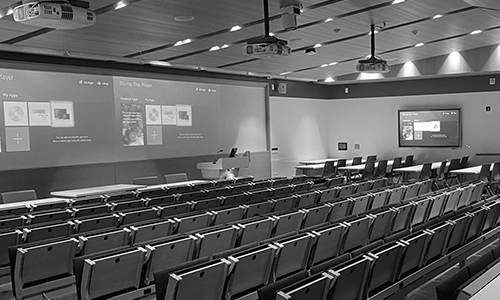Using networked AV and Audinate’s Dante, Joe Way and the audiovisual and IT staff at the University of Southern California were well on their way to being able to support a hybrid learning environment long before the coronavirus pandemic hit.
In a My TechDecisions and Commercial Integrator webinar, the university’s director of learning environments detailed the endless possibilities of the $2 million system that he brought to the Los Angeles campus.
According to Way, he joined the university’s tech team in August with the goal of creating a highly available and intuitive teaching and learning technology experience for the campus community through sustainable, accessible and safe user-centered environments.
Along with a new team of AV professionals and student workers and a heavy reliance on Dante, Way created a sustainable, collaborative IP-based, software-defined AV/IT solution that features a simplified user interface, redesigned AV wall boxes and an overhauled control and monitoring center.
Dante is featured throughout the system, according to Way.
“From start to finish, the entire system runs Dante audio point to point,” Way says.
That created a networked AV system that allows AV signals to be sent from anywhere to anywhere.
“Not just across campus, but across the globe,” Way says.
How networked AV and Dante can solve the COVID-19 education crisis
The U.S. is about a month away from sending students back to class, yet there is still no clear picture of what that will look like. Fully remote, fully on-premises and hybrid learning environments are all possibilities, but COVID-19 has proven to be unpredictable.
However, if USC’s campus were to shut down completely or embrace a hybrid learning model in which some students learn on campus and others learn remote, they’ll be ready. In March when students left the campus due to the pandemic, Way’s office began receiving questions on how the school would be able to support remote learning.
That began a spate of meetings, panic and anxieties to overcome an unprecedented educational challenge.
“I said, ‘We’ve already solved this, actually,’” Way remembers saying. “We already had the plan to do this.”
What began as a project to overhaul the AV in 226 rooms grew to a 318-room project featuring 1,008 Dante nodes and the Dante Domain Manager.
The system was already designed to allow educators to use videoconferencing to connect with a field expert to present to students. Now, it will allow the audio and video to be captured and sent to overflow rooms to accommodate social distancing since the number of students in rooms will be limited.
That same content can be sent to anywhere in the world if students wish to remain of campus, Way said.
“It’s amazing how these use cases seem to grow every day,” Way says.










